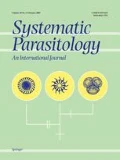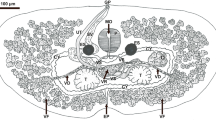Abstract
The common pathogenic prodiplostomulum metacercaria in the flesh, mostly near the skin, of pond-produced channel catfish Ictalurus punctatus has been demonstrated to be Bolbophorus damnificus Overstreet & Curran n. sp. The catfish acquires the infection from the snail Planorbella trivolvis, the only known first intermediate host, and the species is perpetuated through the American white pelican Pelecanus erythrorhynchos, as confirmed by experimental infections with nestling and dewormed adult pelican specimens in conjunction with molecular data. It differs from the cryptic species Bolbophorus sp., also found concurrently in the American white pelican, by having eggs 123–129 μm rather than 100–112 μm long and consistent low values for nucleotide percentage sequence similarity comparing COI, ITS 1/2, 18S rRNA and 28S rRNA fragments. Bolbophorus sp. is comparable but most likely distinct from B. confusus (Kraus, 1914), which occurs in Europe and has eggs 90–102 μm long. Its intermediate hosts were not demonstrated. The adults of neither of the confirmed North American species of Bolbophorus were encountered in any bird other than a pelican, although several shore birds feed on infected catfish, and B. damnificus can survive but not mature when protected in the mouse abdominal cavity. B. ictaluri (Haderlie, 1953) Overstreet & Curran n. comb., a species different from B. damnificus, is considered a species inquirenda.
Similar content being viewed by others
References
Amos, B. & Hoelzel, A.R. (1991) Long-term preservation of whale skin for DNA analysis. Report of the International Whaling Commission, Special Issue 13, 99–103.
Bartoli, P., Jousson, O. & Russell-Pinto, F. (2000) The life cycle of Monorchis parvus (Digenea: Monorchiidae) demonstrated by developmental and molecular data. Journal of Parasitology, 86, 479–489.
Bowles, J., Hope, M., Tiu, W.U., Liu, X. & McManus, D.P. (1993) Nuclear and mitochondrial genetic markers highly conserved between Chinese and Philippine Schistosoma japonicum. Acta Tropica, 55, 217–229.
Brandes, G. (1888a) Die Familie der Holostomeae. Ein Prodromus zu einer Monographie derselben. Dissertation. Reudnitz-Leipzig, Germany, 72 pp.
Brandes, G. (1888b) Über das Genus Holostomum Nitzsch (Vorläufige Mittheilung). Zoologischer Anzeiger, 11, 424–426.
Bykhovskaya-Pavlovskaya, I.E., Gusev, A.V., Dubinina, M.N., Izyumova, N.A., Smirnova, T.S., Sokolovskaya, I.L., Shtein, G.A., Shul'man, S.S & Epstein, V.M. (1964) Key to parasites of freshwater fish of the U.S.S.R. Translation of Russian from Academy of Sciences of the USSR, Zoological Institute, 1962; Jerusalem: Israel Program for Scientific Translations, 919 pp.
Ciurea, I. (1930) Contributions a l'étude morphologique et biologique de quelques Strigéidés des oiseaux ichtyophages de la faune de Roumanie (Recherches expérimentales). Archives Roumaines de Pathologie Experimentale et de Microbiologie, 3, 277–323, with plates 1–17.
Conti, J.A., Forrester, D.J. & Paul, R.T. (1986) Parasites and diseases of reddish egrets (Egretta rufescens) from Texas and Florida. Transactions of the American Microscopical Society, 105, 79–82.
Courtney, C.H. & Forrester, D.J. (1974) Helminth parasites of the brown pelican in Florida and Louisiana. Proceedings of the Helminthological Society of Washington, 41, 89–93.
Cribb, T.H., Bray, R.A., Littlewood, D.T.J., Pichelin, S.P. & Herniou, E.A. (2001) The Digenea. In: Littlewood, D.T.J. & Bray, R.A. (Eds) Interrelationships of the Platyhelminthes. London: Taylor & Francis, pp. 168–185.
Dill, W.A. & Cordone, A.J. (1997) History and status of introduced fishes in California, 1871–1996. California Department of Fish and Game, Fish Bulletin, 178, 414 pp.
Dronen, N.O., Tehrany, M.R. & Wardle, W.J. (1999) Diplostomes from the brown pelican, Pelecanus occidentalis (Pelecanidae) from the Galveston, Texas area, including two new species of Bursacetabulus gen. n. Journal of the Helminthological Society of Washington, 66, 21–24.
Dubois, G. (1935) Contribution à l'étude des Hémistomes (Alari-idae) du Musée de Vienne. Bulletin de la Société Neuchâteloise des Sciences Naturelles, 59(1934), 145–183.
Dubois, G. (1970) Synopsis des Strigeidae et des Diplostomatidae (Trematoda). Mémoires de la Société Neuchâteloise des Sciences Naturelles, 10, 259–727.
Fox, A.C. (1962) Parasite incidence in relation to size and condition of trout from two Montana lakes. Transactions of the American Microscopical Society, 81, 179–184.
Fox, A.C. (1965) The life cycle of Bolbophorus confusus (Krause, 1914) Dubois, 1935 (Trematoda: Strigeoidea) and the effects of the metacercariae on fish hosts. Unpublished Doctoral Dissertation, Montana State University, Bozeman, Montana, 48 pp.
Fox, A.C. & Olson, R.E. (1965) The life cycle of the digenetic trematode Bolbophorus confusus, and effects of water temperatures on the developmental stages. Transactions of the American Microscopical Society, 84, 153–154.
Gallagher, S.R. (1994) Commonly used biochemical techniques, appendix 3. In: Janssen, K. (Ed.). Current protocols in molecular biology. USA: John Wiley and Sons, Inc., pp. A.3.10–A.3.11.
Garber, A.F. (2001) Utilization of a hypervariable region as a molecular marker for red snapper, Lutjanus campechanus, stock enhancement. MS Thesis, University of Southern Mississippi, Hattiesburg, Mississippi, 124 pp.
Garey, J.R. & Wolstenholme, D.R. (1989) Platyhelminth mitochondrial DNA: evidence for early evolutionary origin of a tRNA ser AGN that contains a dihydrouridine arm replacement loop, and of serine-specifying AGA and AGG codons. Journal of Molecular Evolution, 28, 374–387.
Gibson, D.I. (1996) Trematoda. In: Margolis, L. & Kabata, Z. (Eds) Guide to the parasites of fishes of Canada. Part IV. Canadian Special Publication of Fisheries and Aquatic Sciences No. 124. Ottawa: NRC Press, 373 pp.
Haderlie, E.C. (1953) Parasites of the fresh-water fishes of northern California. University of California Publications in Zoology, 57, 303–440.
Hoffman, G.L. (1960) Synopsis of Strigeoidea (Trematoda) of fishes and their life cycles. Fishery Bulletin of the Fish and Wildlife Service, 60, 439–469.
Hoffman, G.L. (1970) Intercontinental and transcontinental dissemination and transfaunation of fish parasites with emphasis on whirling disease (Myxosoma cerebralis). In: Snieszko, S.F. (Ed.) A symposium on diseases of fishes and shellfishes. Washington, DC: American Fisheries Society, Special Publication No.5, pp. 69–81.
Hugghins, E.J. (1956) Further studies on Hysteromorpha triloba (Trematoda: Strigeida), and some parasites of a white pelican. Journal of Parasitology, 42(4-Sect. 2), 26.
Johnsgard, P.A. (1993) Cormorants, darters, and pelicans of the world. Washington, DC: Smithsonian Institution Press, 445 pp.
Jousson, O. & Bartoli, P. (2000) The life cycle of Opecoeloides columbellae (Pagenstecher, 1863) n. comb. (Digenea, Opecoelidae): evidence from molecules and morphology. International Journal for Parasitology, 30, 747–760.
Jousson, O., Bartoli, P. & Pawlowski, J. (1999) Molecular identification of developmental stages in Opecoelidae (Digenea). International Journal for Parasitology, 29, 1,853–1,858.
Kim, W. & Abele, L.G. (1990) Molecular phylogeny of selected decapod crustaceans based on 18S rRNA nucleotide sequences. Journal of Crustacean Biology, 10, 1–13.
King, D.T. (1997) American white pelicans: the latest avian problem for catfish producers. Proceedings of the Eastern Wildlife Damage Management Conference, 7, 31–35.
King, D. T., Paulson, J.D., LeBlanc, D.J. & Bruce, K. (1998) Two capture techniques for American white pelicans and great blue herons. Colonial Waterbirds, 21, 258–260.
Krause, R. (1914) Beitrag zur Kenntnis der Hemistominen. Zeitschrift für Wissenschaftliche Zoologie, Abteilung A, 112, 93–238.
Lenaers, G., Maroteaux, L., Michot, B. & Herzog, M. (1989) Dinoflagellates in evolution: a molecular phylogenetic analysis of large subunit ribosomal RNA. Journal of Molecular Evolution, 29, 40–51.
León-Règagnon, V., Brooks, D.R. & Pérez-Ponce de León, G. (1999) Differentiation of Mexican species of Haematoloechus Looss, 1899 (Digenea: Plagiorchiformes): molecular and morphological evidence. Journal of Parasitology, 85, 935–946.
Littlewood, D.T.J., Rohde, K. & Clough, K.A. (1999) The interrelationships of all major groups of Platyhelminthes: phylogenetic evidence from morphology and molecules. Biological Journal of the Linnean Society, 66, 75–114.
Lo, C.-F., Leu, J.-H, Ho, C.-H., Chen, C.-H., Peng, S.-E., Chen, Y.-T., Chou, C.-M., Yeh, P.-Y., Huang, C.-J., Chou, H.-Y., Wang, C.-H. & Kou, G.-H. (1996) Detection of baculovirus associated with white spot syndrome (WSBV) in penaeid shrimps using polymerase chain reaction. Diseases of Aquatic Organisms, 25, 133–141.
Lumb, S.M., Bray, R.A. & Rollinson, D. (1993) Partial small sub-unit (18S) rRNA gene sequences from fish parasites of the families Lepocreadiidae and Fellodistomidae (Digenea) and their use in phylogenetic analyses. Systematic Parasitology, 26, 141–149.
Manter, H.W. (1963) The zoogeographical affinities of trematodes of South American freshwater fishes. Systematic Zoology, 12, 45–70.
McNeil, C.W. (1949) Notes on the parasites of a white pelican (Pelecanus erythrorhynchos). Northwest Science, 23, 11.
Medlin, L., Elwood, H.J., Stickel, S. & Sogin, M.L. (1988) The characterization of enzymatically amplified eukaryotic 16S-like rRNA-coding regions. Gene, 71, 491–499.
Morgan, J.A.T. & Blair, D. (1998) Relative merits of nuclear ribosomal internal transcribed spacers and mitochondrial CO1 and ND1 genes for distinguishing among Echinostoma species (Trematoda). Parasitology, 116, 289–297.
Olson, R.E. (1966) Some experimental fish hosts of the strigeid trematode Bolbophorus confusus and effects of temperature on the cercaria and metacercaria. Journal of Parasitology, 52, 327–334.
Paperna, I. & Lengy, J. (1963) Notes on a new subspecies of Bolbophorus confusus (Krause, 1914) Dubois, 1935 (Trematoda: Diplostomatidae), a fish-transmitted bird parasite. Israel Journal of Zoology, 12, 171–182.
Pasnik, D. (1999) Research of new trematode in channel catfish. Fish Farming News, Nov/Dec, 40–42.
Proebstel, D.S., Evans, R.P., Shiozawa, D.K. & Williams, R.N. (1993) Preservation of nonfrozen tissue samples from a salmonine fish Brachymystax lenok (Pallas) for DNA analysis. Journal of Ichthyology, 9, 9–17.
Sambrook, J., Fritsch, E.J. & Maniatis, T. (1989) Molecular cloning. A laboratory manual. 2nd Edit. Cold Spring, New York: Cold Spring Harbor Laboratory Press, pp. 1.53–1.73.
Taggart, J.B., Hynes, R.A., Prodohl, P.A. & Ferguson, A. (1992) A simplified protocol for routine total DNA isolation from salmonid fishes. Journal of Fisheries Biology, 40, 963–965.
Terhune, J.S., Wise, D.J. & Khoo, L.H. (2002) Bolbophorus confusus infections in channel catfish in northwestern Mississippi and effects of water temperature on emergence of cercariae from infected snails. North American Journal of Aquaculture, 64, 70–74.
Tkach, V.V., Pawlowski, J. & Sharpilo, V.P. (2000) Molecular and morphological differentiation between species of the Plagiorchis vespertilionis group (Digenea, Plagiorchiidae) occurring in European bats, with a re-description of P. vespertilionis (Müller, 1780). Systematic Parasitology, 47, 9–22.
Turcotte, W.H. & Watts, D.L. (1999) Birds of Mississippi. Mississippi Department of Wildlife, Fisheries and Parks; Jackson, MS: University Press of Mississippi, 455 pp.
Venable, D.L., Gaudé III, A.P. & Klerks, P.L. (2000) Control of the trematode Bolbophorus confusus in channel catfish Ictalurus punctatus ponds using salinity manipulation and polyculture with black carp Mylopharyngodon piceus. Journal of the World Aquaculture Society, 31, 158–166.
Author information
Authors and Affiliations
Rights and permissions
About this article
Cite this article
Overstreet, R.M., Curran, S.S., Pote, L.M. et al. Bolbophorus damnificus n. sp. (Digenea: Bolbophoridae) from the channel catfish Ictalurus punctatus and American white pelican Pelecanus erythrorhynchos in the USA based on life-cycle and molecular data. Syst Parasitol 52, 81–96 (2002). https://doi.org/10.1023/A:1015696622961
Issue Date:
DOI: https://doi.org/10.1023/A:1015696622961




